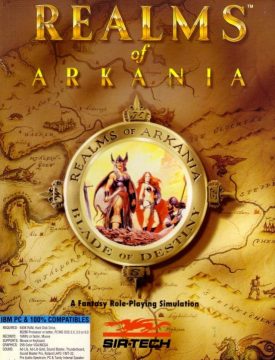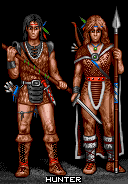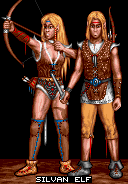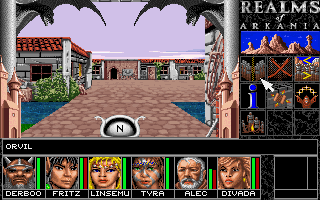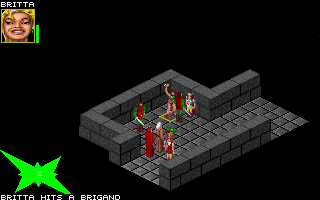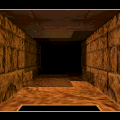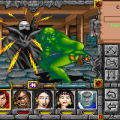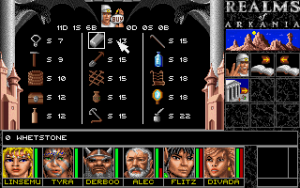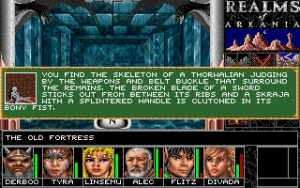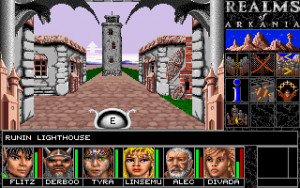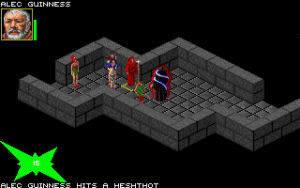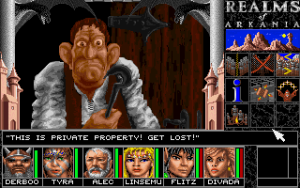The premise of Blade of Destiny is rather simple, but interesting: The city of Thorwal is threatened by an invasion of Orcs, and so Hetman Tronde (a Hetman is something like the mayor of Thorwal) calls out for heroes who are daring enough to retrieve the legendary Hetman Hyggelik’s equally legendary magic sword Grimring, to challenge the Orc champion and thus cross the destructive plans of the blackpelts. The catch is, Grimring has long ago disappeared within the Orclands, buried with his owner, and the only map to its location has been divided among those of his followers who survived the expedition and their heirs. So the heroes are in for quite an odyssey to hunt down the pieces of the map, unearth Grimring, and get to thee Orcish field plains to actually meet their champion, all in time before the scheduled invasion of Thorwal. But first, they have to be born. All six of them.
Realms of Arkania is a role playing game series of the very old school. This doesn’t surprise when knowing that its director, Hans-Jürgen Brändle, used to be a passionate pen & paper RPG player. On the advanced setting, players get to tune their heroes to every minute detail, from the choice whether a weapon skill upgrade should be used for offence or defence, up to their ability to swim, lie to other people or sense danger. The vast number of stats and skills has its drawbacks too, though, and not only are some abilities more useful than others, a few skills don’t even have a single use during the whole trilogy. It soon becomes clear that the series is dominated by the pen & paper spirit. After all, it was even encouraged to use the heroes for further adventures outside of the computer game. Visual customization on the other hand is rather limited, as for each class and gender there are a mere three portraits to chose from.
Creating a hero can become quite a chore, though. Every class, called archetype, has certain criteria for minimum stats, and the stats are determined by rolling virtual dice. More often than not, it’ll end up with values that don’t qualify for any class (consulting the manual while distributing the numbers is obligatory), and there’s no choice but to start all over again. That doesn’t only apply to the seven base values, but also the seven rather unique negative stats, that determine each heroes special weaknesses. There is, of course, the option to chose the class directly, but heroes created by this method are always rather weak builds. Each hero also has a protective god according to the month he was born in, which is assigned at random, so if one really desires a certain bonus, that means even more restarts to get it right.
Speaking of classes, there’s a reason the game calls them “archetypes” instead, and it might seem alienating to people who are used to D&D conventions not to have any distinction between class and race. So in effect, every non-human race is limited to a single “class.” With 12 archetypes, the game uses but a fraction of those introduced in the original pen&paper game, but a lot of those that are missing wouldn’t have made much sense in the scenario, anyway. The available archetypes are as follows:
Hero Archetypes
Jester
The Jester is trained in skills like acrobatics, music and “survival techniques,” but not very useful in hand-to-hand combat.
Hunter
Hunters are not only the right choice to send hunting for food, they are also masters of projectile weapons. Are rendered somewhat obsolete by elves, though, who get magic skills on top.
Warrior
The warrior is the only class that can use the most heavy weapons and armor in the game. Their overall battle abilities make at least one warrior invaluable for each party. Their codex forbids the use of poison, though.
Rogue
Typical rogue skills like pickpocketing and cheating secure a party’s financial integrity, while their ability to wear medium armor and decent proficiency with certain weapon types makes them not a wasted slot in combat at all.
Thorwalian
Practically a “warrior light”, Thorwalians are not allowed to use the heaviest weapon and armor types, without any notable redeeming qualities other than their nordic charm. Thorwalians are very superstitious, which makes them quite vulnerable to magic.
Dwarf
Decent fighters (in the first game, they can even use two-handed weapons, but get nerfed later on) combined with the less morally dubious skills of the rogues. 3/4 of Dwarves in the world of Arkania are male.
Witch / Warlock
A witch or warlock starts out with terrible fighting skills, and quite peculiar house spells. With their only redeeming qualities being herb lore and healing, they’re quite the choice for players seeking for a challenge.
Druid
Another mage user class, druids are not allowed to use equipment made of metal. Most of their strong spells are based around the manipulation of nature.
Magician
They can achieve the most versatile selection of spells of all magic using classes, but also get to chose a specialty magic school. Each magician also hold his personal indestructible staff, which can replace torches and ropes when properly upgraded.
Green Elf
There are three major elven races in Arkania. Green elves live closest to humans and tend to be the most sociable. In the game, they get to wear heavier armor than other elves (but get consecutively nerfed in the sequels).
Silvan Elf
Silvan elves live enclosed in their communities in the woods, and often are viewed as arrogant by humans. They have equal abilities in hunting and archery as the hunter.
When the party is completely created and recruited, it is dropped inside the city of Thorwal, without any further instructions. As with most problems, the solution lies in one of the bars in town. No, really. The bars are the places where most information regarding the quest is to be gathered, be it the residence of local informants or the position of hidden dungeons. They are also meeting places for recruitable NPCs to fill the 7th slot in the party. At first, it’s necessary to learn about the Hetman’s proclamation of his search for heroes.
The next problem: Finding places isn’t always easy, even if one knows what to look for. There are about three different graphics for houses in the game, with no signs or any other visual means of identification for stores. To tell what kind of building lies in front of the party, it is necessary to consult the auto map every time, which shows color coded buildings. The only exception are temples, which get their own individual front tile in the 3D view. There is, however, again no outside indication which god it belongs to before entering, and each god grants different gifts for donating and worshipping. More great news: Homes of important NPCs use the same shade of brown on the map as the hundreds of completely useless commoner dwellings.
After finally finding the Hetman’s residence and getting the assignment, it’s imperative to stock up on equipment, for which the Hetman even awards a small grant from his armory in front. For further shopping, ordinary stores have to be used, of which there are three types. The armory is likely to be the most familiar to any CRPG veteran, but even here they’ll search in vain for any “Flaming Broadsword +3.” The selection of arms is much more down-to-earth, and most weapons look like they’d have made perfect sense in reality. There are magical weapons in the game, but they’re very rare and hard to miss, as there’s no way of telling if a weapon is magical just by looking at it. Magicians’ staffs or witches’ brooms hold magic powers as well, but they’re inalienable from their owners. Then there’s the herbalist, who sells herbs, poisons and potions. Poisons are invaluable for characters with low combat skills to deal massive extra damage, while herbs are used to treat the numerous illnesses that occur in the game. However, characters with a lot of knowledge about herbs get the chance to search for them on their own. The general merchant finally holds all the stuff that would be used in any modern game as pure ambient graphics at best, if it was present at all. Torches, lamps and oil for light sources in dungeons, ropes, blankets and flatware all come in handy during travels. These stores also sell some completely useless stuff, though. Thanks to a bug, whetstones can’t be used until the sequel, for example. At each transaction there’s a chance to haggle the price, but if the party gets too greedy, it might end up getting thrown out of the shop.
Signposts mark exits out of town, and walking into them accesses the travel mode, which makes up a good portion of the whole game. Traveling takes place by foot and by boat, though the former is the standard form of movement. Here it becomes clear how simulation-heavy Blade of Destiny is. The party has to rest every night, take care of food and water, assign guards for the night, and so on. The mountain passes can’t be traveled during winter, and not dressing properly for the season is likely to get someone sick. There are also a lot of random and fixed encounters, some useful, others dangerous, yet others simply annoying.
The ingame map
It is essential to take notes of every hint given. The game keeps an automatic diary, but that is completely useless. Walking aimlessly through the world doesn’t get a party very far, as there are about 50 towns in the area, and most of them are of no direct use to the quest. In fact, a lot of them are of no direct use to anything. There are some random encounters in the towns as well, but most are there just for fun and without any consequences, aside from the occasional pickpocket. If a town holds a temple, it can be used to save the game without any drawbacks, as saving in any other location reduces each hero’s EXP. Usually, it is also necessary to sell loot in the first reachable town after any dungeon raid, as inventory space and carrying weight are strictly limited. Especially items like necklaces or rings are heavy on the space, as there are no separate equip slots for them. However, players who get rid of those magic items will regret it in the sequel, when this problem gets solved. It’s also possible to earn money in bars by cheating in a gamble, doing acrobatics or playing an instrument (pickpocketing isn’t implemented, yet), but usually just selling off all the stuff pillaged from dungeons and enemy encounters provides much more funds than needed.
The main task is basically a multi-layered fetch quest. Hetman Tronde gives hints as to where to look for information, and every informant has to offer more locations and/or a piece of the treasure map, if the player acts properly towards them. Some, however, desire the completion of a certain task before they help the heroes out in turn. Those tasks often require the exploration of a dungeon, but there are also a few completely optional caves and ruins to be found in addition.
Like the towns, dungeons are displayed in a first person view. However, hardly anything is visible here unless at least one in the party is equipped with a light source. Typically, they’re also significantly more dangerous. The designers made it their task to give players a really hard time with instant deaths and red herrings, and even openly make fun of the player occasionally. Most events here are tied to certain spots on the map, but there are also a few random fights. They work similar to dungeons in games like Wizardry, although they are usually fairly smal. The actual graphics window is just as stale as in the towns, and all encounters other than battles are displayed in a text box that pops up. The most numerous dangers stem from traps, some are avoidable with the right skills (usually the leader in the first slot is crucial), but others can even instantly kill the whole party. Some traps and puzzles require the player to split up the party into smaller groups, and switch around between them. It’s technically possible to have each hero walk around separately, even in different locations, but this makes some battles very difficult, and some traps where the heroes are supposed to help each other out unavoidable. Also annoying are a few (optional) riddles that are almost unsolvable without some meta-game knowledge about the setting. Since it is possible to maneuver the group into unwinnable situations, it is advisable to always keep a backup save in the safety of the last visited town. The game is not as brutal as some of its ancestors from the eighties, but it’s no walk in the park, either.
Combat takes place in a tactical quarter view, comparable to SSI’s Dungeons & Dragons Gold Box games. The units on the battlefield take turns, based on their speed and awareness. When attacking, there’s the choice between a cautious, standard, or fierce strike, which determine the hero’s attack and parade values until the next round. Ranged weapons and spells are excluded from this, but their use is rather limited – it is only possible to fire in a straight line, diagonal attacks are not allowed. In turn, they have by far the highest hit rate for low level heroes, while melee combat brings up memories of the very first Final Fantasy game, where a successful attack was almost an event worthy of celebration. Weapons and items can be switched during battles, but that costs Action Points, so their use ought to be well thought-out.
The majority of magical spells are made for combat. In addition to the obvious “Combat” category, every other magic school holds applicable spells. For example, with “Domination” spells enemies can be controlled or scared away, “Transformation” provides stat boosts, while “Demonology” and “Elements” allow the conjuring of otherworldly helpers. The latter ones have to be used with caution though, since the summoned creatures can turn against the caster when the spell fails. There are no spells of mass destruction like D&D‘s fire balls. A big problem with the spells: Their names are very inventive, but less than self-explanatory. This has become an important issue with later releases that skip the appendix about magic in the manual, but it was pretty bothersome to begin with to learn the various spell effects. For boring battles, there’s an option to let the computer take over, but the AI is so dumb that it should really only be used when there’s no doubt about the party’s superiority. Wounded heroes can also flee from the battle, but experience points are only distributed among the characters that stayed active until the end of the fight.
Most dungeon crawls will leave the party in rather poor state. Some members may and will be wounded, poisoned, sick or even dead, and (most) weapons are not indestructible, either. While some of these problems can be solved on the road, and the regeneration of hit points and astral points takes place while sleeping, a hero cannot apply any treatment to him/herself, and also needs to rest after a certain amount of healing attempts, so in bad cases it might be necessary to visit a professional healer. Even those can’t help deceased characters, though, and the only means of resurrection is constant offering and praying at a temple of Tsa, which are very rare in the region. Theoretically, it’s also possible to recruit replacements for dead or lost characters, but this can only be done at the starting temple in Thorwal. Broken weapons have to be taken to a smith, and their repair can take multiple days.
During their exploits, one or more heroes might cross the bar for the next experience level. In expert mode the distribution of EXP is more sparse, but in turn all skill improvement choices are left in the hands of the player. This works the same way as it does during character generation, but the higher the skills get, the more likely it gets to fail at raising them. The level curve is rather steep, and characters won’t exceed level 6 or 7 during the curse of the entire game.
Not much is to be said about the graphics – they’re well done, but there’s just so few of them. This is especially true with the lack of any identification for special buildings in the pseudo-3D window and all the identical-looking dungeon walls. While there are at least three tilesets for the dungeons, every settlement looks exactly the same. As the game was originally released on floppy disks, one might blame disk space restrictions for these shortcomings. On the other hand, space and work is “wasted” on things like two individual towers with no use in the game whatsoever and lots of beautiful art for special locations and events. However, some of those are constantly covered by lots of text, and can really only be seen with a very slow PC or DOSBox setting. The combat graphics are a bit better in that department, but they still suffer from a lack of variety, especially when some enemies look identical to certain character classes, so it becomes hard to distinguish between friend and foe. (There’s no warning before friendly fire, either.)
The shortage in budget and manpower becomes most clear in the behind-the-scenes story of the game’s intro: Those graphics were done by an external artist who wasn’t very familiar with the setting, and so he drew the Orcs in green, pointy-eared standard fantasy fashion. There couldn’t be any more differences with the actual Orcs in the game, which are covered in a thick brown fur, but there just wasn’t any time or money to spare to redo the intro, hence it just stayed the way it was.
Blade of Destiny was developed simultaneously for IBM PCs and Commodore Amiga. A port to the Atari ST was initially announced, but soon cancelled. The Amiga version had to make compromises for the color palette. In turn, it had much better music, which was a big plus, as the lovely melodies really deserve to be heard in the proper quality. It should never be played on an Amiga without hard disk, though. The amount of disk swapping necessary for this version borders on ridiculousness. While the PC floppy versions made do with 4 or 5 disks and required to be installed on the hard drive anyway, on the Amiga the game ran from a whole 8 floppy disks. Just getting started with the game requires 6 or 7 disk changes for Amiga computers with a single floppy drive, and every action in the game results in more swaps. But there are even more drawbacks when playing the game this way: There is no music at all, and female character sprites are all replaced with their male counterparts. An installation really is indispensable.
The PC later received a CD-ROM version that brought a lot of tweaks and improvements. First and foremost, the music now sounded even better than on the Amiga, rendering that version completely obsolete. The graphics also underwent a small upgrade, mainly visible on the city floor tiles. Furthermore, Attic improved the game with a lot of bug fixes and comfort options. Camping in dungeons and cities becomes possible for the first time, as does changing directions in between waypoints during travel. The trading screen now highlights the characters that are able to use a certain item or weapon, some items got rebalanced, and some logical errors corrected – to shoot with poisoned arrows in the disk version for example, one had to poison the bow and not the arrows in the floppy version, which the CD-ROM update corrects.
The success of the game caught the attention of overseas publishers, and thus the game was brought to the US by Sir-Tech in 1993. The localization is overall very solid, although a lot of jokes and pop culture references are lost in translation. In retrospect, there are quite a few inconsistencies with the translation of the following games and especially the later English release of the p&p game, which was overall more source-language oriented. Oddly enough, all experience point values where multiplied by 50, presumably to cater to US gamer habits trained by Dungeons & Dragons. The English floppy version included all the improvements of the CD update minus the music, but brought along a few new bugs.
Those can be found aplenty in every version, though. From plain glitches like permanently reduced stats for no apparent reason, faulty rule implementations like warriors who can’t poison weapons due to their moral codex but very much use them after another character did the job, up to enemies cheating by using ranged weapons in melee combat, every thinkable aspect of the game has one or two flaws. Add the rather archaic and cumbersome handling, and it’s easy to see that Blade of Destiny has aged rather poorly. It’s hard to truly enjoy from a nowadays perspective, but if one manages the hard entrance into the game and takes the pain to get used to its inconvenient conventions, a solid entry to a great classic RPG series awaits.


